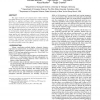Free Online Productivity Tools
i2Speak
i2Symbol
i2OCR
iTex2Img
iWeb2Print
iWeb2Shot
i2Type
iPdf2Split
iPdf2Merge
i2Bopomofo
i2Arabic
i2Style
i2Image
i2PDF
iLatex2Rtf
Sci2ools
VVS
2000
IEEE
2000
IEEE
A practical evaluation of popular volume rendering algorithms
This paper evaluates and compares four volume rendering algorithms that have become rather popular for rendering datasets described on uniform rectilinear grids: raycasting, splatting, shear-warp, and hardware-assisted 3D texture-mapping. In order to assess both the strengths and the weaknesses of these algorithms in a wide variety of scenarios, a set of real-life benchmark datasets with different characteristics was carefully selected. In the rendering, all algorithm-independent image synthesis parameters, such as viewing matrix, transfer functions, and optical model, were kept constant to enable a fair comparison of the rendering results. Both image quality and computational complexity were evaluated and compared, with the aim of providing both researchers and practitioners with guidelines on which algorithm is most suited in which scenario. Our analysis also indicates the current weaknesses in each algorithm’s pipeline, and possible solutions to these as well as pointers for futu...
Real-life Benchmark Datasets | Uniform Rectilinear Grids | Visualization | Volume Rendering Algorithms | VVS 2000 |
Related Content
| Added | 01 Aug 2010 |
| Updated | 01 Aug 2010 |
| Type | Conference |
| Year | 2000 |
| Where | VVS |
| Authors | Michael Meißner, Jian Huang, Dirk Bartz, Klaus Mueller, Roger Crawfis |
Comments (0)

